Essential Elements of a Brand Strategy Framework
Discover a comprehensive brand strategy framework designed to elevate your business. Use this guide to learn how to build a strong brand.


Brand chaos is real—logos slapped together, random colors, and posts that scream into the void.
But with a clear brand strategy framework, you’re not just winging it on social media marketing—you’re playing chess while everyone else plays checkers.
Ready to build a brand people can’t ignore?
Let’s map it out.
Key takeaways
-
What is a brand strategy framework? It’s your go-to plan that outlines how your brand shows up online—what you stand for, how you speak, and how you stay consistent across every touchpoint.
-
How to build platform-specific strategies:One-size-fits-all doesn’t work—tailor your content and voice to match the audience, vibe, and format of each platform.
-
Ways to grow brand communities across channels:Keep your audience engaged by sparking conversations, encouraging content creation, and showing up consistently with value.
-
Helpful tools and metrics to guide your strategy:Use social media analytics, brand health metrics, and competitive benchmarks to understand what’s working—and double down on it.
Understanding brand strategy fundamentals
When it comes to developing a brand strategy, there are a few basic things every social media strategist should understand.
What is a brand strategy?
A brand strategy is a long-term plan that outlines how a brand will achieve its social media goals (and not only) and connect with its target audience.
It’s more than just the formulation of a mission—it's a combination of brand development strategies that define your brand’s identity as a whole.
This strategy serves as a roadmap, guiding how your brand communicates, positions itself in the market, and builds lasting relationships with customers.
How has social media transformed traditional brand strategy approaches?
Once upon a time, brands were built in boardrooms—crafted by a few executives, polished by ad agencies, and carefully broadcasted to the masses.
But the rise of social media shattered that model.
Suddenly, consumers became co-creators, critics, and cheerleaders all at once.
The impact of social media on businesses is undeniable—brands are no longer just what they claim to be but what their audience says they are.
This shift forced a reimagining of the brand-building framework.
It’s not just about defining your message but continuously adapting it, listening to your audience, and maintaining an authentic dialogue.
In a world where a single tweet can shape perception, your brand strategy must be agile, interactive, and deeply customer-centric.
The interconnection between overall brand strategy and social media presence
Your brand building strategy and social media strategy aren’t two separate worlds—they’re two sides of the same coin.
One defines your brand’s essence—while the other is where that essence gets tested, challenged, and celebrated in real time.
A strong brand strategy ensures you know who you are, but your social media strategy makes sure the world knows too.
It’s where your brand story becomes a conversation, where your values meet public scrutiny, and where your promise is either proven or broken.
Thus, they must dance together.
Pre-framework assessment: auditing your current brand position
Naturally, before knowing how to build a brand strategy, you need to understand where you stand.
A solid pre-framework assessment starts with gathering competitive insights and running a social media audit—so you’re not just guessing, you’re positioning with purpose.
Brand perception analysis techniques for social channels
A good first way to audit your current brand position is by leveraging interactive content features across social media platforms.
Tools such as polls and Story questions allow you to directly engage with your audience and gather valuable feedback in real time.
This form of social media analysis is incredibly effective because it provides immediate insights into how your audience perceives your brand, which can help you identify areas for improvement.
By actively listening to your followers, you can adjust your brand-building strategies to better align with customer expectations, making your approach more targeted and successful.
Competitive landscape mapping across platforms
Competitive benchmarking provides a holistic view of how competitors are positioning themselves and performing, which can help you identify trends, strengths, weaknesses, and opportunities.
By tracking metrics like follower growth, engagement rates, post frequency, and audience interaction, you gain insights into their strategies and content effectiveness.
For example, looking at how Semrush and Ahrefs perform on LinkedIn, Instagram, and Facebook helps us understand which platforms and tactics resonate most with their audiences.
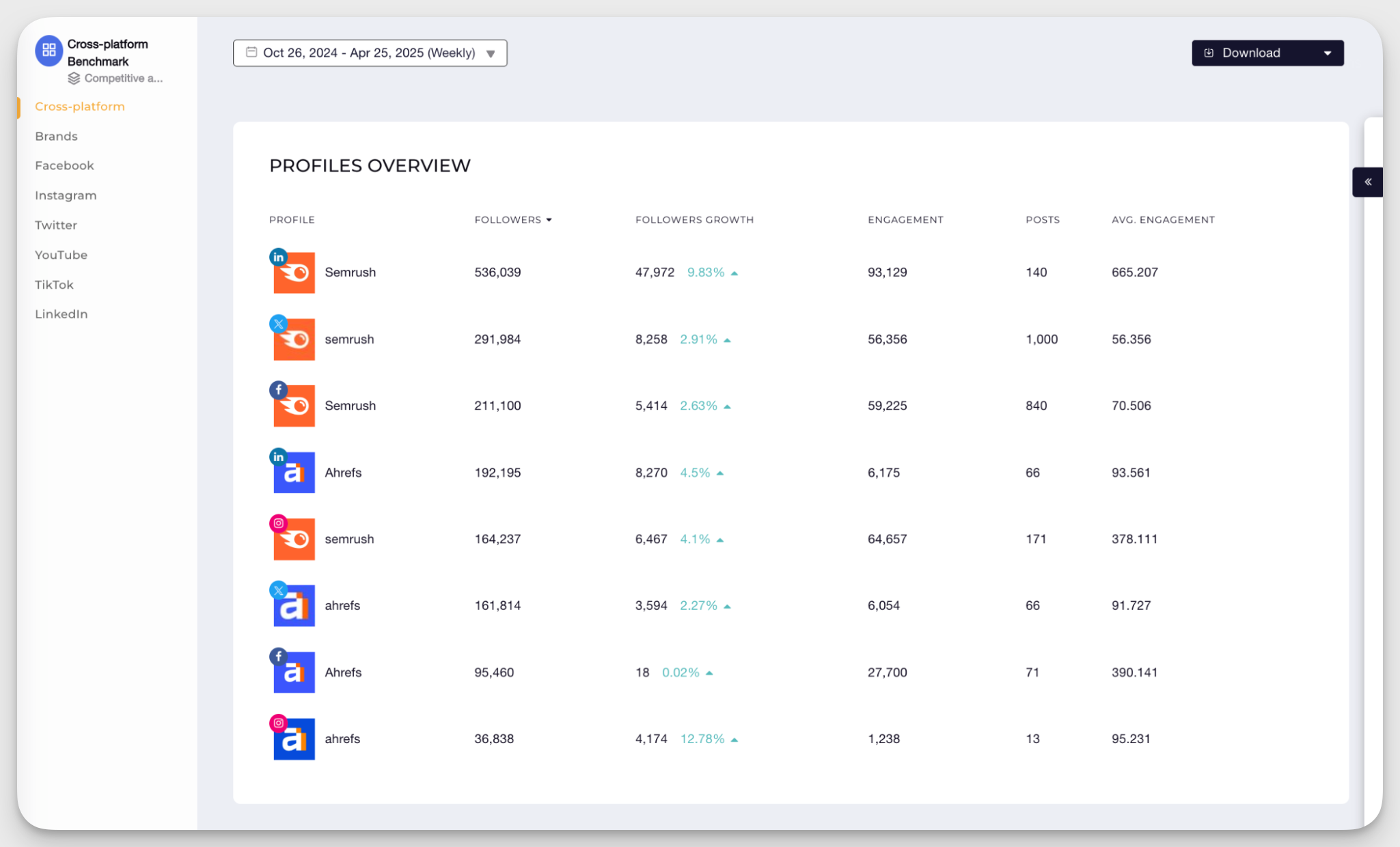
Ultimately, gathering competitive intelligence is essential because it provides data-driven insights to make informed decisions and optimize your own marketing and engagement strategies.
Identifying your brand's strengths and weaknesses in the social sphere
Strategic brand development starts with a well-put social media SWOT analysis.
Understanding where your brand thrives and where it falls short is key to refining your social media strategy.
To help you get there faster, Socialinsider’s executive summary provides a comprehensive overview of your brand’s performance across key metrics like follower growth, engagement rates, and posting frequency.
Moreover, it not only highlights how your brand is performing but also offers actionable advice to improve your strategy.
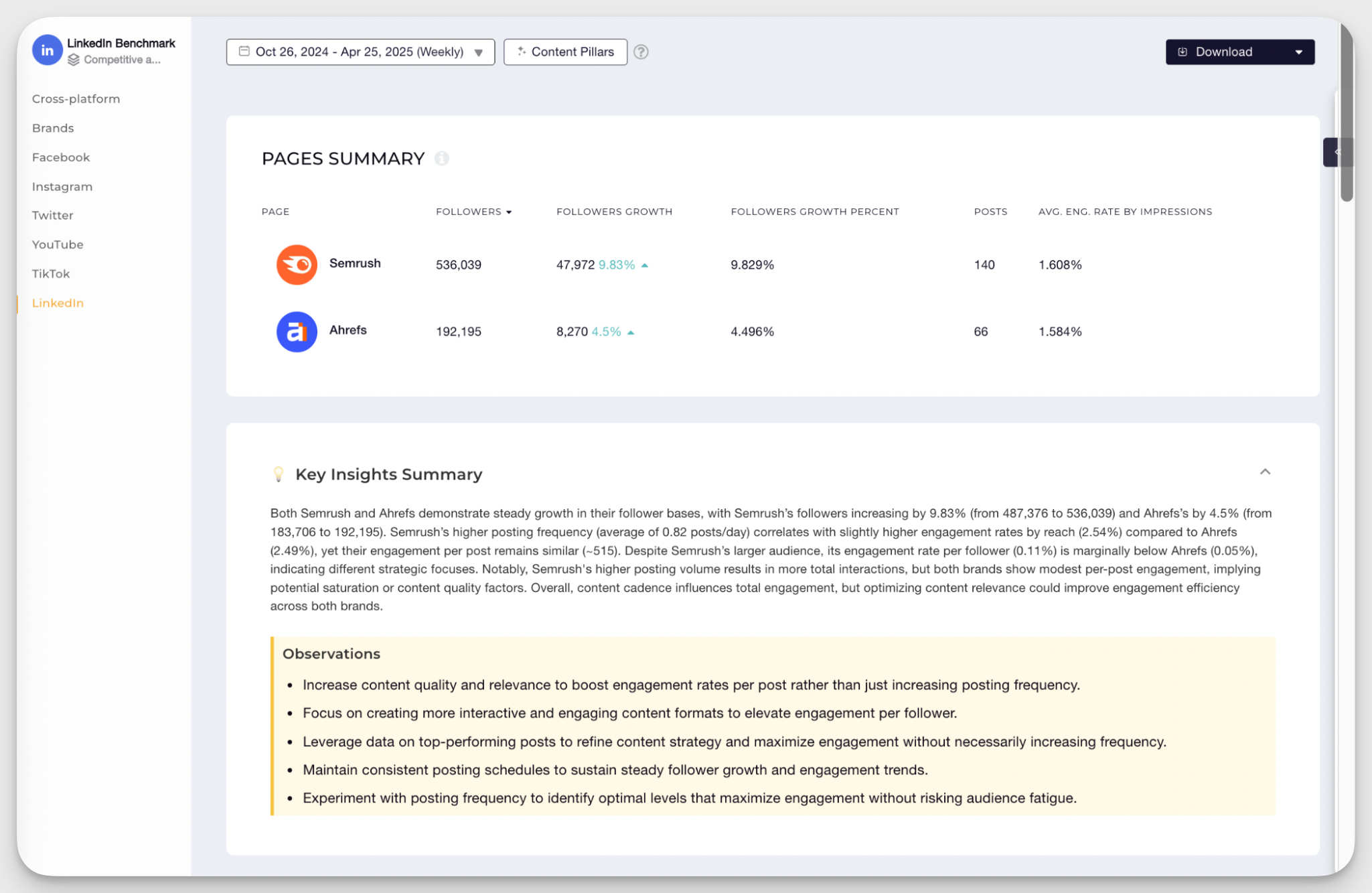
And by comparing these social media insights to competitors, you can easily spot your strengths—whether it’s high engagement or consistent growth—and identify areas for improvement, such as content relevance or posting consistency.
The core components of a social media brand strategy framework
But what does creating a brand strategy involve?—you might ask.
Let’s break it down.
Brand purpose and vision for each channel
Developing a brand strategy goes beyond spreading the same message everywhere; it’s about understanding the essence of each platform and adapting accordingly.
Imagine each social media space as its own universe: Instagram is your art gallery, LinkedIn is your boardroom, and TikTok is a vibrant playground.
Each platform serves a different purpose and attracts a different mindset, which is why your brand’s purpose must shift to meet the expectations and behaviors of the people there.
Thus, knowing how each stage operates allows you to strategically position your brand in a way that feels ambitious, relevant, and engaging in that specific environment.
Target audience definition and platform-specific personas
One of the core components of a brand strategy is understanding your audience on each platform is more than just knowing their age or location—it involves understanding how they *use* the platform.
Naturally, a teenager scrolling through TikTok has a different mindset than a professional browsing LinkedIn.
By crafting specific social media personas for each platform, you’re not just speaking to a group of people, but to the unique way they engage with content.
This lets you create messages that caters directly to their needs, interests, and behavior.
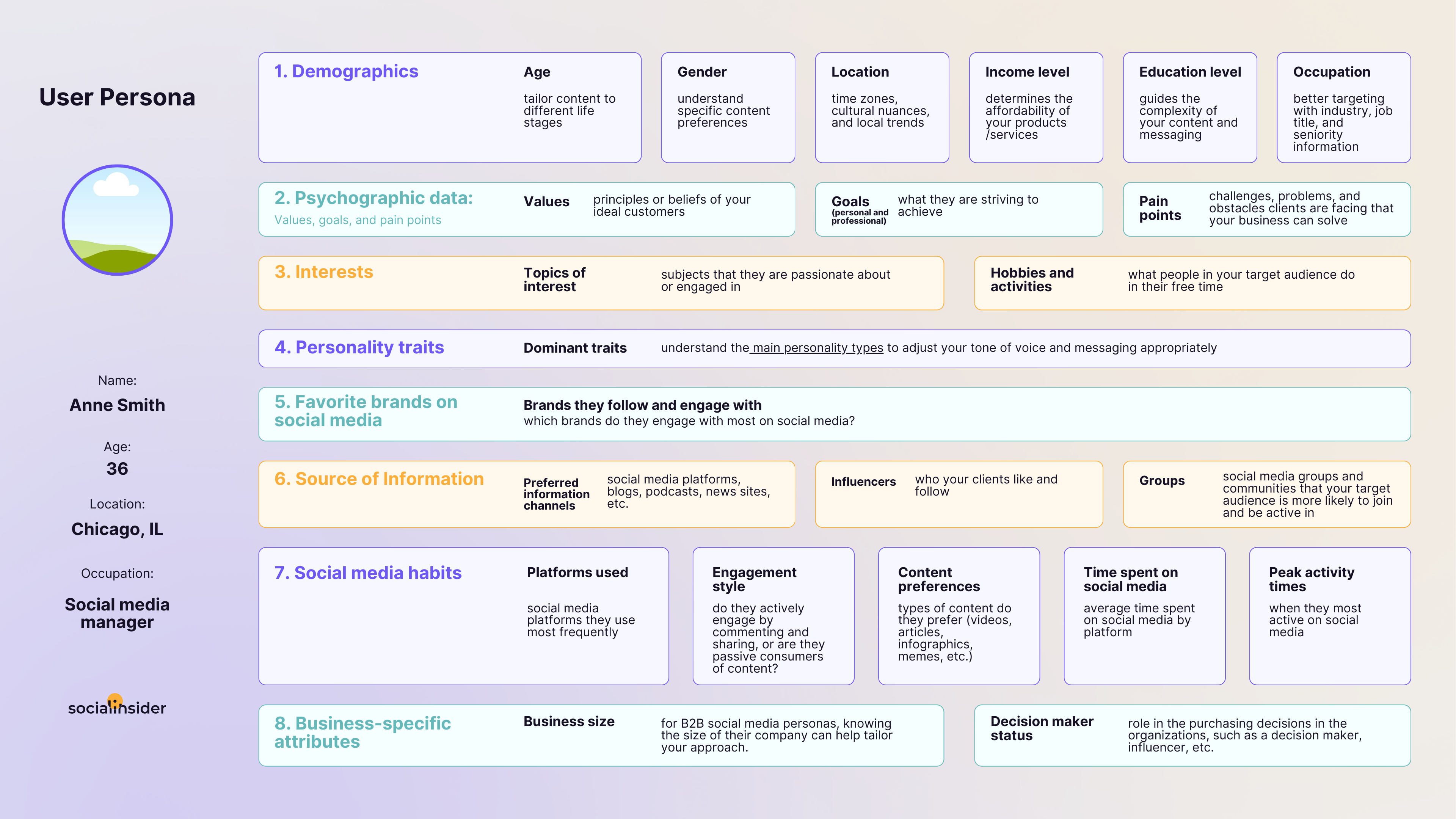
Brand positioning and differentiation in crowded social spaces
In a sea of content, how do you make your brand stand out?
By carving out a space that’s uniquely yours.
Brand strategy and positioning aren’t about shouting louder, but about being clearer and more relevant than the noise around you.
Find what makes your brand different—whether that’s your point of view, your tone, or your expertise—and make that the heart of your social presence.
Once you know how you fit into the social landscape, you can confidently create social media content that not only stands out but becomes a go-to resource for your audience.
Brand voice and personality adapted for each social channel
Sure. Your brand’s voice should feel authentic everywhere, but it doesn’t have to sound the same on every platform.
The key is to adjust your personality to fit the context of each social space.
Adapting your voice to each platform’s strengths ensures your content feels native to the environment, enhancing how your audience interacts with your brand and making them more likely to engage.
Visual identity system optimized for social media formats
Your visual identity is another key brand strategy component. And it needs to work seamlessly across all platforms.
Social media is a visual-first experience, so the way your brand looks can make or break engagement.
Thus, the key is optimization: your logo might be tiny in an Instagram story but dominate the space in a YouTube thumbnail.
Having a flexible, platform-optimized design system ensures your brand shines, whether it’s through eye-catching graphics or instantly recognizable colors.
This attention to detail creates a unified look that feels effortlessly professional, no matter where your audience encounters you.
Platform-specific strategy development
As we mentioned before, each platform offers a unique audience, format, and communication style, so crafting platform-specific strategies is a game-changer.
This section dives into how to adapt and develop a solid strategy tailored to the specific nuances of each social network, ensuring maximum social media reach and engagement.
Tailoring your brand presence for specific platforms
When we talk about tailoring your brand’s presence on different platforms, we’re referring to the need for adjusting your voice, content types, and engagement methods to match the platform's vibe and user behavior.
Whether it’s the visual-centric nature of Instagram, the professional tone on LinkedIn, or the fast-paced, meme-driven culture on TikTok, every platform has its own set of unspoken rules.
A platform-specific strategy means you’re not just throwing content out there — you’re engaging users in a way that resonates with them, respects the platform’s ethos, and amplifies your brand message.
It’s about finding the perfect mix of consistency in brand identity, while adapting content to fit the format and audience of each platform.
Platform-specific content pillars and messaging hierarchies
Once your brand presence is adapted to each platform, you need to implement platform-specific content pillars for social media and define messaging hierarchies.
This involves categorizing your content into distinct pillars that reflect your brand's objectives while also speaking to certain behaviors.
On LinkedIn, for example, our content is divided into pillars such as industry news, product education, original research, and entertainment content.

Each one ensures a well-rounded and strategic approach to content that engages users at different stages of their journey with your brand.
But, hey—these content pillars aren’t random.
They’re based on understanding what the platform values and what will most likely drive engagement and reach vs. impressions.
Thus, not only do they provide a structure for posting, but also ensure your social media marketing efforts are aligned with both the platform’s culture and your brand strategy development, creating a strong and consistent presence across channels.
Content strategy within your brand framework
Still wondering what are the best practices when creating a brand strategy for social media?
Let’s see what you need to consider:
Creating a content ecosystem that reinforces brand values
When you weave your core values into the content you share, you create a unified voice that your audience can connect with, no matter where they encounter your brand.
For example, at Socialinsider, we do this by crafting social media performance reports that don’t just present data, but spark conversations that matter.
We listen to what strategists are curious about, addressing those questions through content that speaks to their needs.
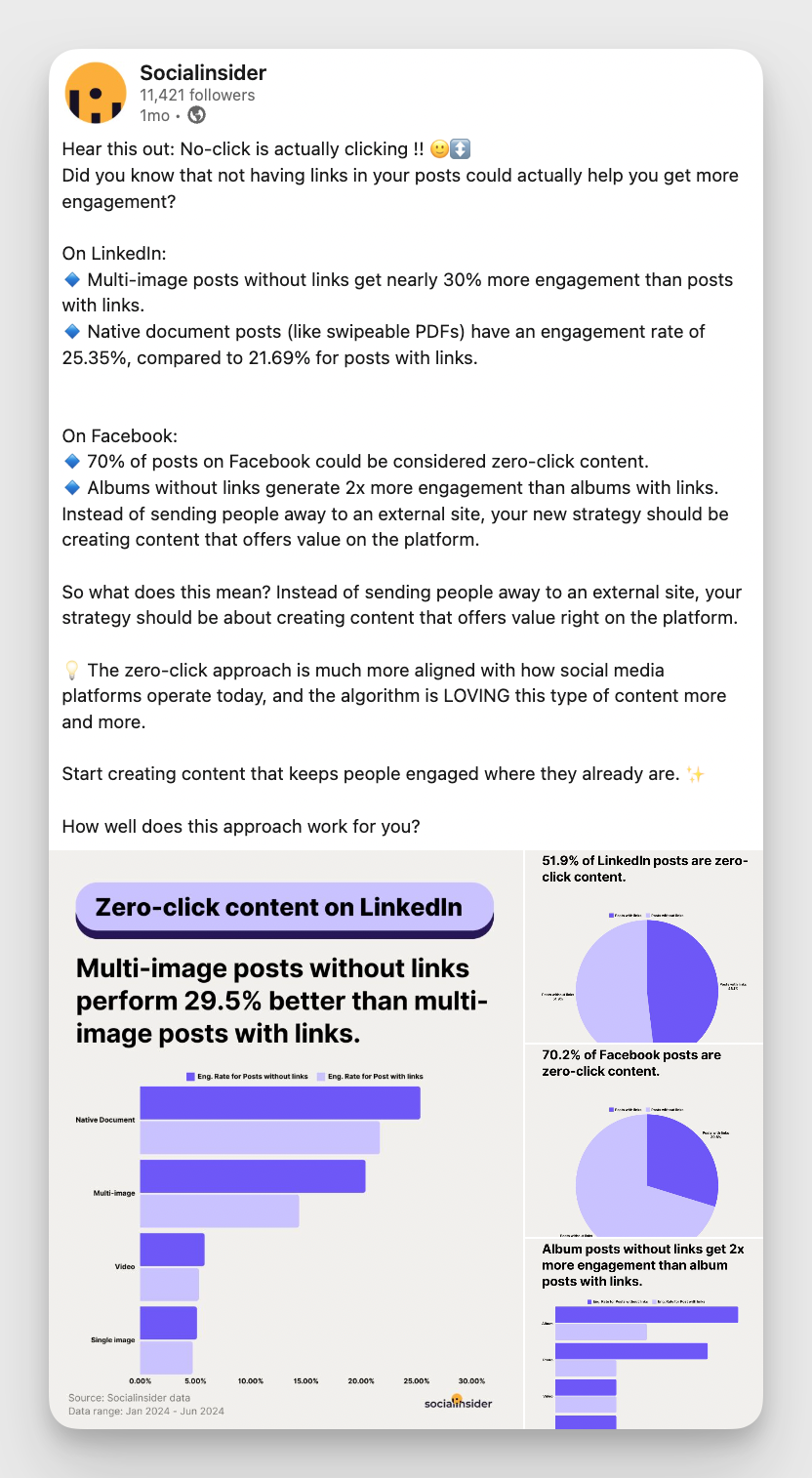
Our strategy of sharing insights from our reports, aligns with Socialinsider's mission - that of providing enterprise-level data for the challengers in the market, helping them sharpen their strategies, all while reinforcing the brand’s commitment to meaningful, actionable results.
It’s how we make data feel less like numbers and more like a story that everyone can be part of.
Content types and formats that build brand recognition
Content types and formats aren’t just tools; they’re the brushstrokes that paint your brand’s identity.
To carve out lasting brand recognition, you need more than just eye-catching visuals—you need content that resonates, that sparks conversation, and that aligns with your values.
At Socialinsider, we’ve turned this philosophy into a science.
Through our social media benchmark reports, we’re not just presenting data; we’re creating content that challenges norms, fuels strategic discussions, and keeps brands ahead of the curve.
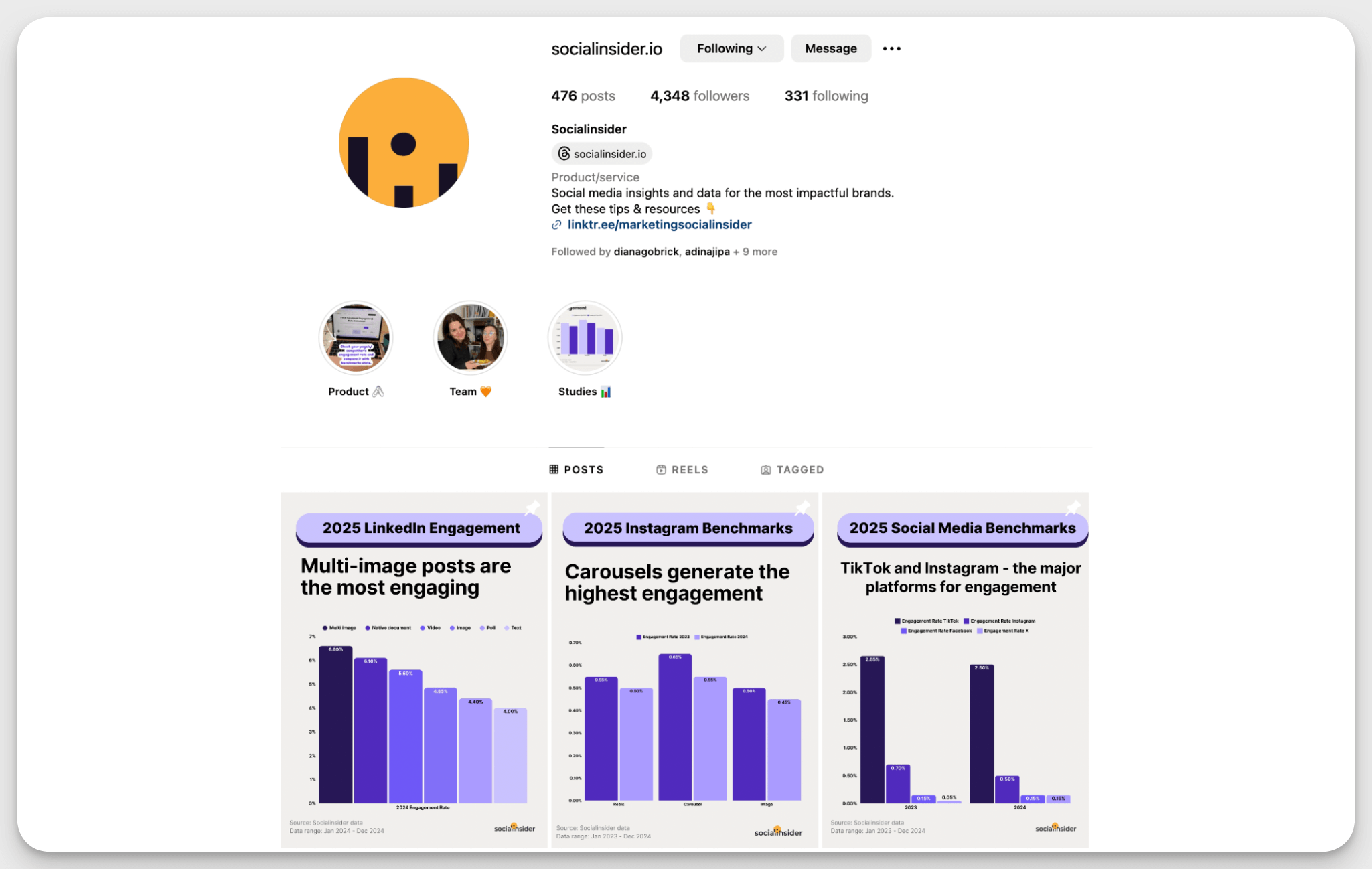
Our insights shape the conversation and drive engagement, establishing a brand presence that’s both bold and unforgettable.
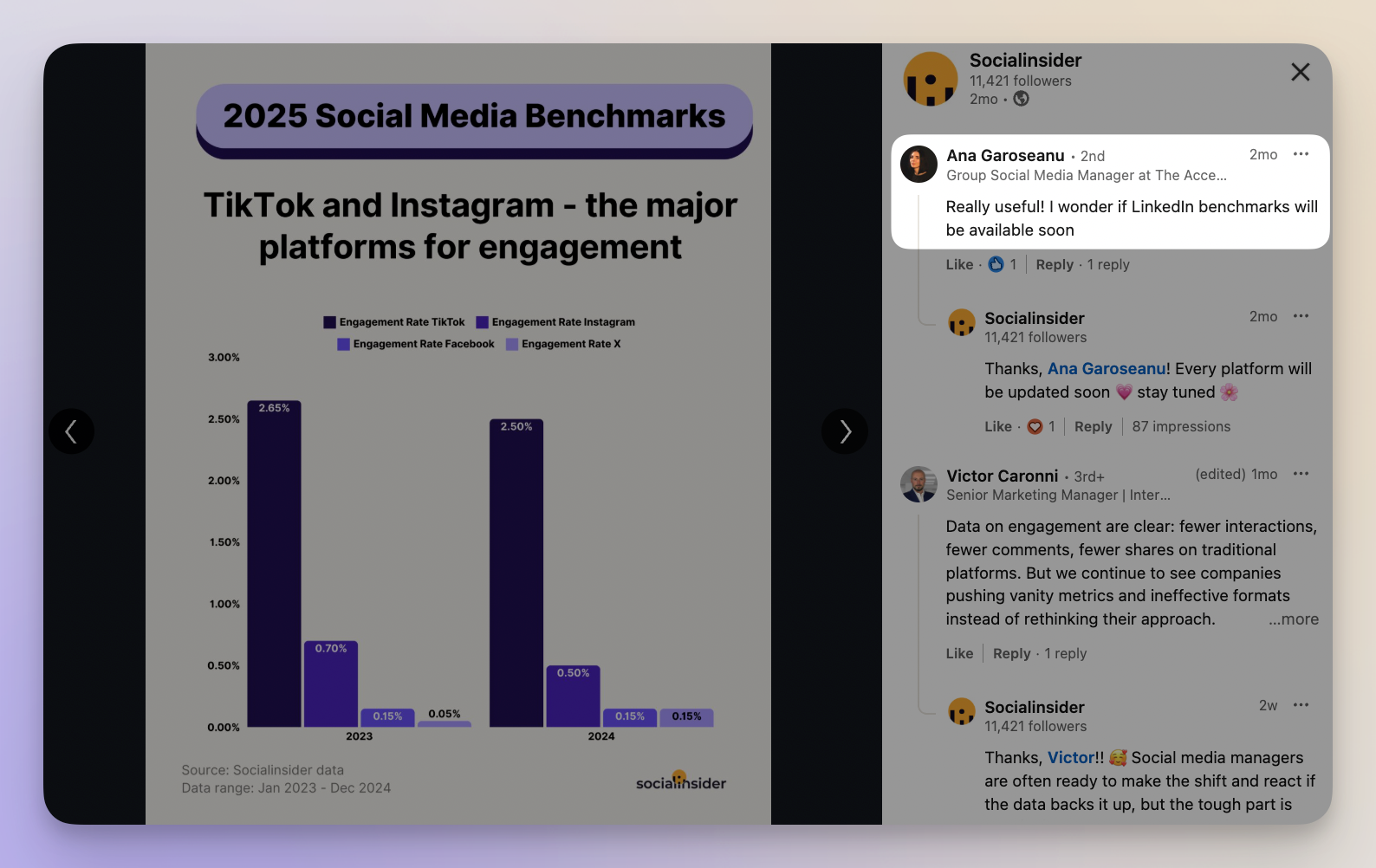
User-generated content integration strategies
When it comes to user-generated content, it’s not about hoping your audience will engage—it’s about crafting a strategy that practically *begs* for it.
Socialinsider's approach?
Turn our reports and studies into a spark that ignites conversation.
With a strategy development framework that intertwines product updates, thought leadership, and industry insights, we don’t just talk at our audience; we create a playground where they can jump in, share, and contribute.
It’s less about creating one-off content and more about establishing a continuous loop that keeps the momentum alive.
Content calendar development aligned with brand objectives
Creating a content calendar shouldn’t be about filling space, but more about finding a flow that keeps your audience hooked and moves you closer to your objectives.
At Socialinsider, we use ours to align with key social media KPIs, making sure every post has a purpose.
Whether it’s driving engagement, boosting impressions, or sharing insights, each piece of content is crafted with a goal in mind.

Looking at the draft, you can see how we mix things up—some fun, some informative, some focused on products—always aiming to hit the mark.
Community building as a brand strategy pillar
To truly understand how effective social media marketing is, you need to look at your social media community.
A strong, engaged community is the backbone of any effective brand strategy.
Techniques for fostering brand communities across platforms
Let’s uncover some of the best social media practices for building your community.
Proactive engagement
Proactive social media engagement is all about creating that back-and-forth with your audience.
By initiating conversations, responding to comments, and encouraging participation, you create an environment where followers feel valued & heard.
Just like in the example below, a simple, relatable comment can spark a conversation and invite followers to share their own experiences.

By showing your brand's personality in the moments, you build a genuine connection with your community, and that connection fosters loyalty and engagement.
Sharing BTS content
Behind-the-scenes (BTS) content brings your community closer to your brand by showing the human side of your business.
This type of content makes followers feel like insiders, offering them a peek behind the curtain.
In the example below, we see a fun, relatable moment captured at the office, emphasizing that our brand isn’t just about products or services—it’s about the people behind it.

Rewarding the most active followers
It’s these little gestures that help nurture long-term, meaningful relationships with your audience.
And recognizing and rewarding your most active followers can build loyalty and encourage more interaction.
Whether it’s through shout-outs, exclusive content, or even a simple thank-you message, making your followers feel appreciated for their contributions can deepen their connection to your brand.
This can also be done through contests, giveaways, or spotlighting top followers in your community.
Turning followers into brand advocates
Turning followers into brand advocates is an essential part of building a brand strategy that creates lasting impact.
But how can you do that?
Well, the answer might be simpler than you’d think.
When you engage authentically, share value, and make people feel heard, they naturally evolve into passionate supporters of your brand.
And this happens when they begin to identify with what you stand for—they don’t just follow, they become advocates.
For example, one of our followers recently shared our LinkedIn benchmarks study on engagement trends, highlighting how much they appreciated the insights.

This kind of organic advocacy speaks volumes—it’s a real sign that our community feels invested and believes in what we stand for.
Measurement and optimization
No brand strategy process is complete without social media measurement and optimization.
It’s essential to track your progress, identify what’s working, and refine your approach to ensure continued growth and engagement.
This step ensures your strategy stays on course and evolves with your audience's needs.
Key performance indicators for brand strategy effectiveness
To measure the true success of your brand strategy, collecting and tracking the right social media data is crucial.
So here are the most important social media metrics to monitor:
Followers and follower growth rate
Tracking the number of followers and growth rate shows how well your content resonates with new audiences.

Reach
This metric reveals how far your content is spreading across the platform.
It’s a great indicator of visibility and helps you understand if your posts are reaching new potential customers.

Engagement rate
The engagement rate shows the level of interaction between your content and your followers.
Needless to say, a higher engagement rate means your audience is actively connecting with your brand.

Comments, shares and saves
These interactions measure how much your content is sparking conversations, getting shared, and being saved for future reference.

Higher numbers in these areas indicate that your audience finds your content valuable and worth spreading.
Data-driven refinement of your social media brand strategy
This section breaks down how to use raw data to sharpen your content and posting strategy for better results.
- Optimize your content calendar and posting based on the best-performing content formats
One of the best social media tips we can give you is to optimize your content calendar and posting schedule based on the best-performing content formats.
Why?
Because when you rely on social media analytics, you can fine-tune your approach by focusing on what actually resonates with your audience.
Instead of posting on a whim, you’re strategically timing your content based on the data that shows what performs best.

When we reviewed our LinkedIn content data, we saw that text posts, which have registered an 18% increase in usage YoY on LinkedIn, perform especially well for us, making 20.47% of our top posts (as shown in the image above).
These posts draw attention, provide more value, and encourage interaction, making them a clear winner in our strategy.
- Analyze your top-performing posts and identify patterns
The key here is to take a good look at your brand measurement framework and dig into the numbers.
What content gets people talking? What do they love sharing?
When we analyzed our posts, we found that memes absolutely kill it on Instagram; they get higher engagement, more shares, and even spark conversations in the comments.

You can see the power of this in the engagement and comments distribution charts, like the one above.
These brands metrics help us understand exactly what’s resonating with our audience, allowing us to double down on formats that get the most love.
By analyzing patterns like this, you’re able to shift your strategy to create even more of what works.
Tools recommendations for tracking brand performance
Now that you’ve mastered the basics of data-driven strategy, it’s time to equip yourself with the right social media analytics tools to track your brand’s performance effectively.
Here are a couple of standout options:
- Socialinsider: This tool provides in-depth social cross-channel analysis and competitive benchmarking, giving you a clear view of how your brand is performing across various platforms and how you stack up against the competition. With Socialinsider, you can track key metrics, gain actionable insights, and adjust your strategy accordingly.
- Looker Studio: Perfect for those managing multiple data sources, Looker Studio offers seamless integration across different platforms, enabling you to pull all your key metrics into one place. This tool helps you create custom reports and dashboards to get a complete picture of your brand’s social media performance, streamlining your analytics process.
Final thoughts
Hopefully, by now, you’ve learnt that a brand strategy framework is part manifesto, part moodboard, part master plan—built on sharp purpose, scroll-stopping looks, and a voice that actually speaks to your audience.
Analyze your competitors in seconds
Track & analyze your competitors and get top social media metrics and more!
You might also like
Improve your social media strategy with Socialinsider!
Use in-depth data to measure your social accounts’ performance, analyze competitors, and gain insights to improve your strategy.




